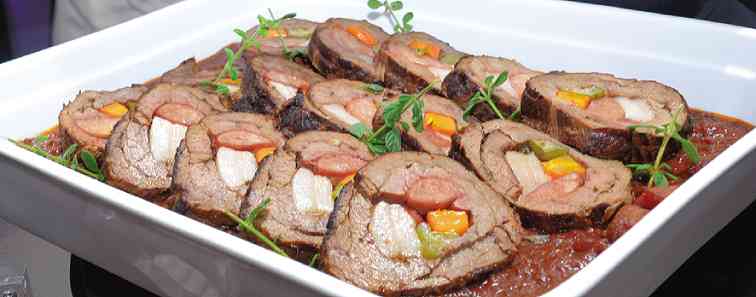
Dishes are set on the La Veranda bar, each one the recipe of a mother, grandmother, even a great-grandmother. These are the family dishes of the chefs and outlet manager of Sofitel Philippine Plaza, presented to highlight the celebration of Mother’s Day.
Filipino chef Bettina Arguelles unveils her grandmother’s dishes of beef morcon and gambas al ajillo, the latter not the puny-sized shrimps found in many restaurants but one that uses king prawns. The morcon is party-ready, the meat roll with the stuffing of vegetables neatly arranged.
‘Lola’s’ cooking
Arguelles talks about her grandmother (lola) whose house in Singalong, in the old part of Manila, held many lunch and dinner parties because her grandfather, Prudencio Langcauon, was secretary of education during President Elpidio Quirino’s time. She smiles as she recalls holding on to her lola’s skirt while lola cooked in the kitchen.
The passion has rubbed off on her, because she works at Sofitel as “French chef.” That means she cooked all the dishes of the French food and beverage staff presented at La Veranda.
That should include executive chef Eric Costelle’s ratatouille, his great-grandmother’s recipe. The dish makes me look for an article I read about this vegetable dish from Provence and the mothers and aunts, and yes, grandmothers, who do it. It is in a collection of travel and food essays (“Provence, The Collected Traveler”) by Jeffrey Robinson.
The author wrote how he would wake up early to go to the market in Nice to watch women in black choosing the vegetables and haggling with women in similar clothing. Every stall sold tomatoes, zucchini, and so on.
There have been musings that ratatouille is our Ilocos pakbet. Two of the vegetables are similar—eggplant and tomatoes—but the big difference is that ratatouille needs constant stirring, and that the vegetables are cooked separately, each with its proper cooking time.
Neat layers
The old ladies Robinson met at the market were “full of advice”: Don’t be stingy with olive oil, for instance. Simmer the vegetables, don’t boil. Add the tomatoes after the rest of the vegetables are cooked.
The women agreed that ratatouille has to be stirred. So Robinson titled his article for Gourmet magazine, “A Stirring Treatise on Ratatouille.”
The old women of Nice did not have a complicated ratatouille dish like the one cooked by the “rat chef” in the Disney movie. It is supposed to be a simple dish, a bit like the mishmash of pakbet, not the neat layers of vegetable that is the version called confit byaldi made by chef Thomas Keller of The French Laundry and Per Se for the movie.
But simple can be misleading, as those are usually dishes that can’t be corrected if one starts out wrong. Such are the dishes that Filipino chef Romeo Malate did—his grandmother’s tilapia cooked in coconut milk (guinataan) and the grilled eggplant and green mango salad from his great-grandmother.
Chocolatier Tweet Obsequio amazes again with her rendition of chocolate bags, lipstick and even shoes, the latter with durian jam enfolded to remind everyone that her roots are in Mindanao.
In his spiffy barong, Sofitel food and beverage director Damien Marchenay makes me view first his great-grandmother’s baeckeoffe, an Alsatian casserole of vegetables with foie gras and aromatic truffles under a pastry. Too bad I do not get to sample it, as all the dishes are in several stations and looking for them in the huge Spiral buffet is like an Easter egg hunt.
Thankfully, we can eat the dessert of Marchenay’s grandmother, the clafouti, a French fruit pie originally made with black cherries but that day includes other fruits such as the blackberries and peaches.
Everyday dishes
Grandmothers are generally remembered for the everyday dishes they cooked. My paternal grandmother, Lola Cael, used the pork intestines she was given at the market to express the fat, then went on to make quintessential Ilocano dishes.
My maternal grandmother, Lola Pitang, was a great cook. Nora Daza once told me that she asked for the recipe of the cochinillo my lola cooked inside an ordinary oven. I never saw my lola do that, but my son said he saw his great-grandmother do it. I am glad that the next generation witnessed it—something to pass on to the next generation.
It will be a busy Mother’s Day celebration at Sofitel because, apart from the tribute to the great family cooks, Spiral will also feature Ilocano dishes.
There will also be demos of crafts such as the Ilocos Norte abel weaving and a fashion show featuring the woven Iloco cloth. Abel weaving is one art passed on usually from mothers to daughters, just like the cooking of family recipes.
Call 8326988. E-mail the columnist at pinoyfood04@ yahoo.com









































